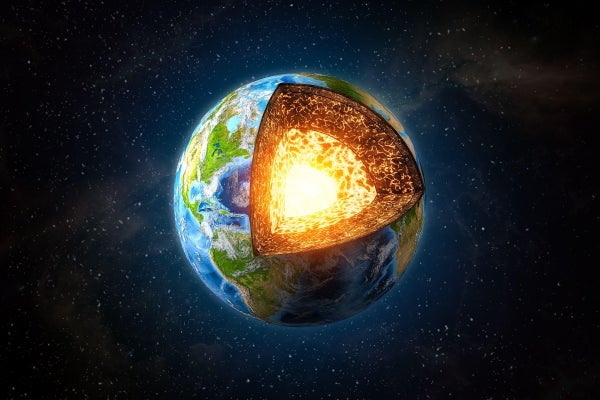The spin of Earth’s inner core may have slowed, with the heart of the planet now rotating at a slightly more sluggish clip than the layers above, new research finds. The slowdown could change how rapidly the entire planet spins, as well as influence how the core evolves with time.
For the new study, published in the journal Nature Geoscience, scientists used a database of earthquakes to probe the behavior of Earth’s solid inner core over time. The inner core sits suspended like a ball bearing in the molten-metal ocean of the outer core. Because of this liquid cocoon, the “ball bearing” may not spin at the same rate as the rest of the planet. Over the years, some researchers have found that the core rotates slightly faster than the mantle and crust, a condition called “super rotation.” But studies have not returned consistent numbers, with the first study to observe differential core rotation estimating that the inner core rotates up to one degree faster per year than the rest of the planet; others found an annual speedup of just tiny fractions of a degree.
These differences aren’t dramatic. The variation in rotation time between the inner core and the rest of Earth is very minor. Nor are the differences a threat to life on the surface: In contrast to the 2003 science-fiction movie The Core, there’s no need to call in a crack team of geophysicists and astronauts to drill to the center of our planet and start blowing things up. At most, the inner core rotation might influence Earth’s overall spin and contribute to fluctuations in the planet’s magnetic field. Each year the core expands by about a millimeter, as some of the molten iron in the outer core solidifies, seismic studies have shown. The solidification also drives the circulation of the outer core, which, in turn, creates the planet’s magnetic field. The rotation of the inner core could influence this solidification process in ways that are not yet fully understood, thus impacting the magnetic field, says study author Xiaodong Song, a geophysicist at Peking University in China.
On supporting science journalism
If you're enjoying this article, consider supporting our award-winning journalism by subscribing. By purchasing a subscription you are helping to ensure the future of impactful stories about the discoveries and ideas shaping our world today.
The rotation might also matter for how the inner core grows over billions of years, says John Vidale, a geophysicist at the University of Southern California who was not involved in the study, but who has researched core rotation.
The catch, however, is that no one really knows how fast the inner core spins. In the new study, Song and geophysicist Yi Yang, also at Peking University, found that the core appeared to hold a steady spin, faster than the overall spin of Earth, between the 1970s and the early 2000s. Around 2009, though, that spin rather abruptly slowed to match Earth’s speed and then perhaps slowed so much that the rest of the planet now spins faster, Song says.
Song and Yang measured this spin by using pairs of almost-identical earthquakes that originated at the same spots, separated only by time. Because the quakes are nearly identical, their shock waves should also look identical when they travel through the core and back out, where they are detected by seismometers around the planet—that is, unless the core itself changes and alters the path of one earthquake’s waves relative to the other. If the core is spinning differently than the rest of the planet, identical earthquake waves that happen months or years apart will hit the core at slightly different spots and therefore bounce back with some subtle differences. The researchers compared quake waves going back to 1964 to track the changes in how the core might be moving over time. If they’re right, the spin of the core now lags that of the overall planet by a tiny amount.
“We are hypothesizing that this [slowed rotation] will continue in the coming years and decades, and we should be able to see that in [our] relatively short human time frame,” Song says.
The new findings likely won’t end the debate over the inner core. The work is well done and does an admirable job of combining different data, Vidale says. But there are several competing explanations for what’s going on. For example, Vidale’s research hints that the core may alter its rotation every six years or so, while researchers Guanning Pang and Keith Koper reported a single “lurch” in the early 2000s and little change since in a 2022 study. “I don’t view [the new work] as entirely conclusive,” Vidale says.
Lianxing Wen, a geodynamicist at Stony Brook University, who was not involved in the new study, also researches the core’s spin. He doesn’t believe the inner core spins any differently than the rest of the planet. A better explanation for the changes in seismic waves that travel through the core, Wen says, is that the surface of the inner core isn’t smooth like a ball bearing but rather uneven and constantly changing. “We believe the inner core has a shifting topography that best explains observed temporal changes of seismic waves that reflect off the inner core,” he says. The new research, Wen says, misinterprets these changes as caused by the core’s spin rather than to its fluctuating surface.
Fortunately, Song says, the seismic monitoring of Earth is better than ever, yielding far richer data about the planet’s interior than in earlier decades. By continuing to watch earthquake waves, the researchers should be able to show whether they’re right about the inner core’s spin.
“The exciting news,” Song says, “is that we don’t have to wait too long.”
